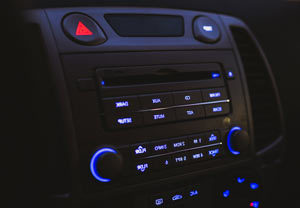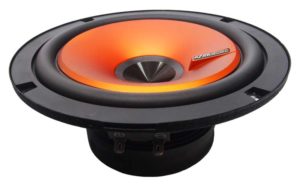 You take your music wherever you go. You have to have your before work jam session or the calm relaxation in the evenings. The car is really the place where you have the most control of what you listen to. The only problem is that most cars are not inherently good acoustic spaces. They are metal boxes covered in plastics and fabrics. Designers and companies have few options for speaker placement, and that usually means your speakers are going in the door. It’s where they fit best. But, if there are issues with the drivers or installation, your listening experience could be diminished by a number of annoyance factors. If you are experiencing some of these distractions and dying to help your car sound better, working on the front doors is usually the best bang-for-your-buck as far as improving overall sound is concerned.
You take your music wherever you go. You have to have your before work jam session or the calm relaxation in the evenings. The car is really the place where you have the most control of what you listen to. The only problem is that most cars are not inherently good acoustic spaces. They are metal boxes covered in plastics and fabrics. Designers and companies have few options for speaker placement, and that usually means your speakers are going in the door. It’s where they fit best. But, if there are issues with the drivers or installation, your listening experience could be diminished by a number of annoyance factors. If you are experiencing some of these distractions and dying to help your car sound better, working on the front doors is usually the best bang-for-your-buck as far as improving overall sound is concerned.
Doors are a convenient place to put speakers, but this area potentially lends itself to a few problems that could range from just having a bad set of speakers, a poor installation, or even road noise interference. You will want to know the root cause of your problems. Ask yourself a few pre-diagnostic questions like; Are my speakers handling too much or did I blow a speaker? Are things buzzing? Does my sound get worse when I drive on the highway? There are a few ways to improve the quality of the sound coming from your door speakers if you notice these issues. To begin, you’ll want to get your tool kit ready with some screwdrivers, plastic pry bars, potentially some foam and tape, and whatever else you may need to remove the door panels and put them back on in the end.
The Door Speakers
If you are getting distortion straight from the speakers when they are trying to handle more complex songs at higher volumes, your car may have a low quality coaxial speaker set or a damaged speaker. Replacing your current speakers for a component set will be the absolute best thing for this problem. Upgrading from a coaxial to a component set is a great start to improve the sound in your doors, though it involves the installation of a few more speakers. If you don’t want to worry about more speakers but have the money to spend, you could also simply purchase a better set of coaxial speakers that will do better at higher volumes and with a more diverse range, but component speakers generally will sound better. The upside to a coaxial set is that it will require only a straight swap out of the old for the new. Make sure that you buy the same size as your factory set. Larger speakers will require custom work to get them to fit, and smaller speakers will require an adapter plate (sometimes called a baffle). It is easier to install a smaller than stock speaker, but you will sacrifice efficiency and low end response in doing so. smaller speakers also handle low midrange worse, which could result in thinner sounding vocals.
Not So Good Vibrations
 A common problem with car doors is unwanted vibration. The bass gets pumping and it starts to sound like your door is shaking apart. This could be caused by mechanisms in the door rattling around, but it’s just as likely the panel itself rattling against the sheet metal beneath it. Start your check by pressing on various parts of the door, with the panel on at first, to find the exact location of the vibration. Check wherever there are moving parts including the handle area and the locks. It could also be that the speaker itself is vibrating around in its slot. Companies put foam around this opening to secure the speaker, and to help separate sound waves from the back/front of the driver, but the foam could have fallen off, gotten worn down, or no longer be enough if you have beefier aftermarket speakers put in. Once the source is located, make sure that the mechanisms are not coming loose, then dampen the vibrations with a bit of foam. Taping or gluing things down may also help, but just make sure you don’t strap something down that needs to move. If your door panel is vibrating, make sure it gets sealed properly to the door. This may take a little while to identify everything, but you won’t ever regret clearing up your sound quality this way and cutting out annoying vibrations.
A common problem with car doors is unwanted vibration. The bass gets pumping and it starts to sound like your door is shaking apart. This could be caused by mechanisms in the door rattling around, but it’s just as likely the panel itself rattling against the sheet metal beneath it. Start your check by pressing on various parts of the door, with the panel on at first, to find the exact location of the vibration. Check wherever there are moving parts including the handle area and the locks. It could also be that the speaker itself is vibrating around in its slot. Companies put foam around this opening to secure the speaker, and to help separate sound waves from the back/front of the driver, but the foam could have fallen off, gotten worn down, or no longer be enough if you have beefier aftermarket speakers put in. Once the source is located, make sure that the mechanisms are not coming loose, then dampen the vibrations with a bit of foam. Taping or gluing things down may also help, but just make sure you don’t strap something down that needs to move. If your door panel is vibrating, make sure it gets sealed properly to the door. This may take a little while to identify everything, but you won’t ever regret clearing up your sound quality this way and cutting out annoying vibrations.
Highway Robbery
Another occurrence that will compromise your sound is road noise. If your car is not insulated properly, this noise will cut into your sound quality, most noticeably the lower frequencies, and leave your playlists sounding harsh as you turn up the volume to compensate for road noise. If this describes your experience, you can fix this quite easily (but not necessarily inexpensively!) by installing some vibration damping and/or sound deadening material to both the inner and outer door skeleton. The material does a few things- it reduces the amount of vibration of the door panel and lowers the resonant frequency of the door panels, ideally below the frequency that human ears can hear. This will not deaden the sound from your door speakers, but it will give you a more pleasant driving experience with less of the droning noise of the highway getting in, thereby getting you better performance with lower volume levels.
I’m Totally Baffled!
To really take things to the next level, you need to improve the baffle – that is, the wall that separates the back and front of the speaker. The thin plastic panel that makes up the interior of your car is a poor excuse for a baffle. Next time you look at a pair of high end home stereo speakers, knock on the side of it, and notice the high pitched, tight sound it makes. Now, tap on your car’s plastic door panel, and consider how much that thin sheet of plastic is effected by a speaker vibrating right next to it.
Most speakers produce sound waves on both sides of the cone, and these sound waves are opposites. So when the sound waves from the back mix with the sound waves from the front, they cancel each other out. This is most noticeable in the lower frequencies- effectively killing your bass. What you want to do is create a solid wall between the front and back of your speaker, using your car door as the framework to make this happen. There are a few ways to do this- some use products like second skin or Tander. Others will create custom panels using cutting board material, or well, pretty much anything (but cutting board material is ideal). It depends on how powerful a speaker you want to install, and how much time/money you are willing to spend.
Congratulations!
You have taken control of your listening life and now get to enjoy a far superior listening experience! If you have a new set of speakers, cheers! Otherwise, you have just improved the sound from your car doors simply by improving the environmental factors around the speakers and made your car sound healthier overall.



